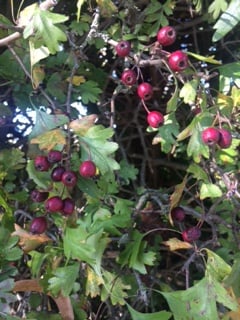
With the encroaching cold there is propagation to be done in unheated greenhouses or cold frames: hawthorns for hedges. Until recently I had a few hawthorn trees along the boundary with my neighbour, but we have chopped them right down to the base. The idea is to encourage them to sprout from the ground to start to form a hedge that can seamlessly replace the geriatric fence when it finally gives up the ghost. But there are gaps and we are going to want some more plants, and this is the time to propagate.
Propagating hawthorns is a slow business, but we are in no big rush, and winter can help. It’s also an enjoyable process, working with the season and joining in here and there to move things along. Proper gardening. There are loads of haws around, even here in Bristol where it is used as a hedging plant in wilder spots, though I gathered mine from the hedge alongside Tesco which I’m not sure quite counts as wild… Gather up your handfuls and throw them into a bucket, because the first task is extracting the seed. Half fill the bucket with water and leave them to soak for a few days, changing the water each day. Then drain off most of the water, leaving a little behind, and bash the softened fruits with something flat ended – I used a rolling pin for mine, until they are a mush of seeds and flesh.
Fill the bucket and the unviable seeds and flesh should float to the top, easy to skim off, leaving the viable seeds at the bottom of the bucket. Next I sowed these seeds across the top of a couple of pots of gritty compost and covered them in grit. We now need to subject the seeds to a period of cold. This is where the cold frame or the cold greenhouse is useful – they will provide the chill the seeds need to break dormancy, while also offering a little protection from the full on elements. If your greenhouse is insulated or heated at all this wont work, and you should pop them in the cold frame where they will have no warmth at all. The frost will work on them all winter long. Wherever you put them, label them, water them and then pretty much forget about them.
Then wait. Put them aside. Forget about them. A full eighteen months will pass before they start to germinate, in around February of the second year, and in the meantime they should just get a little trickle of water every now and then to keep them ticking along. Once they start to germinate it is a good idea to make them a well-worked nursery bed outside, sprinkle them across it, and water them in.I have a patch of the allotment earmarked for this.
The same technique can be used to propagate any autumn berries – roses from rosehips, blackthorns from sloes. The benefit of propagating from seeds is always in the variety it throws up: each of the plants will flower at a very slightly different time, leaf up at a different moment, have subtly different haws, making them less likely to all be damaged or wiped out by a freak frost or a particular disease. By picking and sowing from parent plants that are growing in your area you are also selecting for plants with characteristics that are suited to your conditions: if the parent plant didn’t like it where you live then it wouldn’t be healthy and covered in berries now. It’s slow, but satisfying, and will make a beautiful, healthy, varied hedge in the end.


